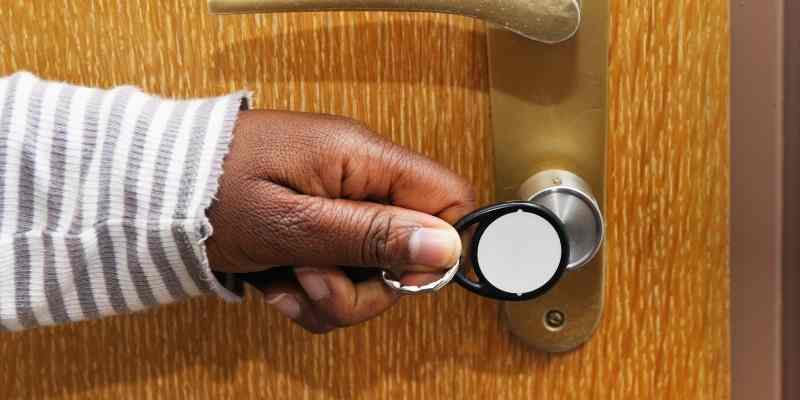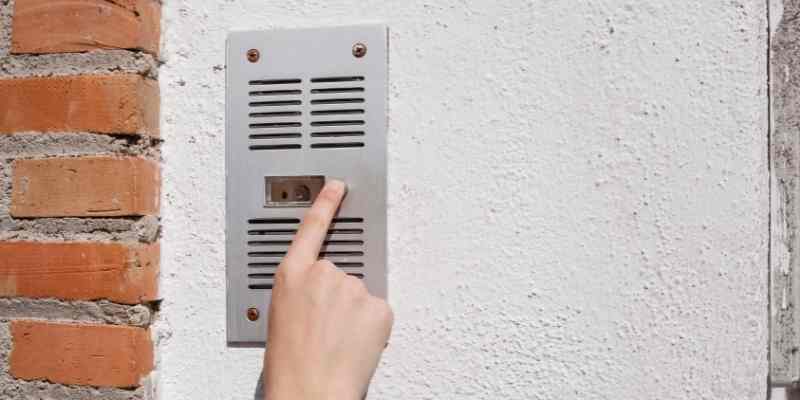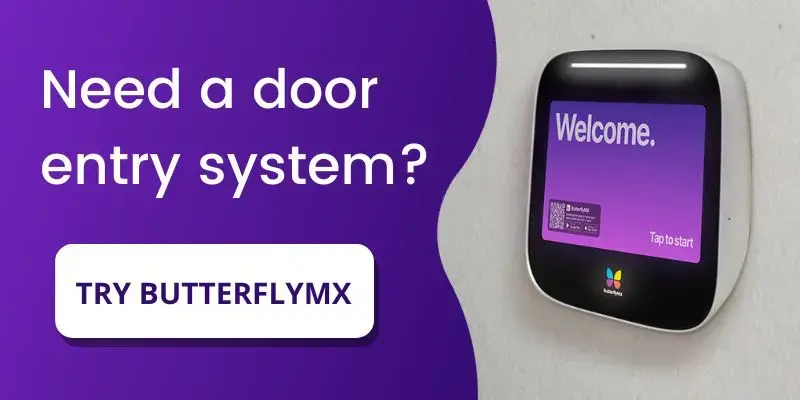Key takeaways
- What is a commercial entry door: It’s an entryway in a commercial building that you’re securing with access hardware like a video intercom or a keypad.
- Commercial door entry systems work by maintaining an electronic database of user credentials and opening the door after verifying a credential.
- Types of commercial door entry systems include buzzer systems, electronic access systems, and telephone entry systems.
- The right commercial door entry system for your property has features like wireless connections and multiple ways to open the door.

Every building has valuable assets that need to be secured. With a commercial door entry system, you can control who has access to your property. From intercoms to fobbed access, door entry systems make your commercial building safer.
But choosing a commercial door entry system is a big decision, so we’ve put together this guide to help you choose the best system for your building or business.
This post covers:
- What is a commercial door entry system?
- How does a commercial door entry system work?
- 4 types of commercial door entry systems
- Things to look for in a commercial entry door system
- The right commercial door entry system
What is a commercial door entry system?
A commercial door entry system is an access control solution that allows you to manage who can access doors on your property. With a door entry system, you can set limits on who has access to the building or rooms within it and at what times.
Door access control systems for businesses use hardware like:
- Video intercoms
- Keypads
- Card readers
- Fob readers
- Smart locks
Every property needs controlled access for security purposes, but you also don’t want to hinder access for tenants. With a door entry system, you can keep doors locked while ensuring tenants and authorized visitors can enter seamlessly.
There are many kinds of commercial door entry systems to meet the unique needs of various commercial buildings. For example, office buildings have many repeat visitors Monday through Friday, while storage and retail spaces have frequent deliveries at odd hours. Either way, these properties need an effective entry system.
Watch how ButterflyMX controls door entry at commercial buildings:
How does a commercial door entry system work?
A commercial door entry system works by allowing staff and tenants in a commercial building to grant access remotely and communicate with visitors.
There are three essential components to all commercial door entry systems:
- Base station. The hardware installed at the property’s entrance.
- Substations. Devices installed throughout the building to communicate with the base station.
- Magnetic lock for door access control system. After receiving instructions from the base station, the magnetic lock has components that physically release and allow a tenant to open the door.
These devices combine to make a door entry intercom system where people outside the building can communicate with people inside. Both devices have a microphone and speaker to transmit audio at the push of a button.
Beyond the most basic features, a modern door entry system can also include:
- Commercial intercom system with door release mechanisms
- Cameras for video calling
- A mobile app
- Cloud-based software
- RFID technology
- Bluetooth
- ADA push buttons
What is the average cost of an entry door?
To manage security for a commercial door, you can be expected to pay anywhere between $250 and $3,000 depending on the features you want and the hardware you’re interested in.
In addition to that upfront installation cost, you also might pay a monthly software fee.

4 types of commercial door entry systems
There are many building entry systems on the market these days, so choosing the right one for your commercial property can feel overwhelming.
Here are the four main types of business access control systems:
1. Video intercom systems
A video door entry system is installed at the entrance of a property so that tenants can grant property access to visitors remotely. Notably, the video component allows tenants to visually confirm who’s requesting access before opening the door or gate.
When purchasing a commercial video intercom, choose one that pairs with a mobile app for smartphone-based access. That way, building staff won’t have to hand out physical credentials — instead, tenants can manage access from their own smartphones.
Pros:
- A video intercom entry system is convenient and affordable to install because there is no wiring and no in-unit hardware.
- Smartphone-based access is convenient and more affordable than installing devices in every unit.
- With a cloud-based video intercom, you can manage permissions and access time- and date-stamped audit trails from anywhere.
- Video intercoms enable easy keyless entry because tenants can admit themselves and visitors all from their smartphones. Tenants can also type in a PIN code to access the door.
Cons:
- Video intercom systems are designed for multi-tenant properties with more than 10 units.
- The features may be too extensive for smaller buildings or businesses.
Watch how ButterflyMX works:
2. Electronic access control systems
Electronic systems like key fob and RFID card readers go one step beyond a traditional metal lock and key. These technologies verify who is accessing the door based on the credential they use to enter. But while an access control system streamlines access for tenants and staff, it doesn’t enable visitor access.
Pros:
- Most electronic access systems are easy to use for tenants. All it takes is tapping a key card or fob against a reader to enter the building.
- Fobs and key cards are easy to replace under a card access system. When tenants inevitably misplace a card, you can disable access for that card and issue a new one easier than with metal keys.
- RFID readers are also effective for elevators. With these door security systems, you can also easily regulate who can access particular building floors.
Cons:
- They can only be used by tenants who are issued cards or fobs. There’s no way for visitors to contact tenants and request access through an RFID reader.
- Even though key cards and fobs are cheaper to replace than metal keys, the costs still add up. Tenants are less likely to lose their smartphone than a key card, so a smartphone-based access system saves money in the long run.
- Hackers and fraudsters can easily purchase an RFID copier that can clone a resident’s key card for as little as $11. However, if your fobs or cards are encrypted, this is not an issue.
- If a resident loses their key fob or card, someone else could use it to access the building before staff gets around to deactivating it.
Electronic access control systems work best when combined with a video intercom. Tenants can also use the RFID reader as a backup method for entering the building. However, they have the convenience and security of the video intercom for letting in deliveries, guests, and more.

3. Buzzer systems
Door buzzer systems are named after the buzzing sound they make when someone requests access. Visitors press a button on a device at the property’s entrance to request access. From there, tenants can talk to the visitor and open the door for them.
Pros:
- A buzzer system allows tenants to grant access to visitors and deliveries without physically going to open the door for them.
- Buzzers can save time for building or front desk staff because visitors can request access directly from a tenant.
- Using a buzzer system is intuitive. Visitors have almost certainly used one before.
Cons:
- Tenants cannot use a buzzer system to let themselves into the building — it’s for visitors only.
- Buzzer systems require extensive wiring, which is expensive to install and maintain.
- Because a buzzer system requires in-unit hardware, there are a lot more devices involved than with a smart video intercom. Maintaining all those devices is a lot of work.
- There is no video calling with a buzzer system, so tenants cannot visually confirm who is on the other end of the call. Also, administrators don’t have access to a video audit trail.
- Tenants must be onsite to grant access because there is no mobile app with remote features.
- Staff will have to update the tenant directory manually onsite instead of through an online portal.

4. Telephone entry systems
Telephone entry systems have been around for over a century. The device operates on a traditional telephone line, allowing visitors to call tenants from outside the property. It requires hardware installed at the entrance and a telephone to receive the calls.
Pros:
- Tenants can admit visitors when they receive a call on their phone.
- Most telephone entry systems are easy to use, and visitors can call the tenant with the push of a button.
- Calls can be sent to tenants directly, which can save staff time answering the door.
Cons:
- The system is for visitors only. Tenants need another method of accessing the property, such as an access control system.
- Wiring a phone line is an involved process and expensive to maintain. Installation can require construction and much higher labor costs than wireless door entry.
- There is no way to grant recurring access for providers like cleaning staff or delivery couriers who visit regularly.
- The tenant directory must be updated manually, so staff must be onsite to manage the system.

Things to look for in a commercial door entry system
You should look for features like:
Mobile app
One of the essential features of a smart door entry system is the top-rated mobile app. This empowers tenants and staff to open doors and control access from their smartphones.
Remote management
Make sure you can control access and manage the system from anywhere in the world.
That way, you can view entry logs, adjust permissions, manage integrations, and add or remove tenants without being onsite.
Visitor and delivery access management
Choose a system that allows tenants and staff to send digital access codes to guests. With a digital credential, everyone from cleaning staff to business clientele can access the property at approved times.
Easy installation
Wireless video intercoms are quick and affordable to install because there’s no in-unit hardware or building wiring. As a result, they are also easier to maintain over time.
The right commercial door entry system
A smart video intercom system from ButterflyMX is the right commercial door entry system for properties and buildings of all sizes.
ButterflyMX is easy to install, convenient to use, and provides a holistic access control experience throughout your entire property through integrations and other ButterflyMX access control devices.
Unlike buzzers and telephone entry systems, everyone who comes to the property can intuitively use the ButterflyMX Video Intercom System. Tenants, staff, visitors, and delivery couriers can all gain access through the Video Intercom.
ButterflyMX commercial door entry system
ButterflyMX offers a complete access solution that’s perfect for all kinds of commercial properties, from office complexes to self-storage facilities. Further, the ButterflyMX mobile app has over 40,000 five-star reviews from people all over the country who use it every day to access their properties.
The next generation ButterflyMX intercom features:
- Seamless access. Installed at your property’s entrance, the ButterflyMX Video Intercom enables seamless access for tenants, staff, visitors, and delivery carriers alike. And the intercom’s 156° wide-angle camera takes a picture of every entry event for added security.
- Stylish and secure. The top-rated Video Intercom System has an inviting design that adds plenty of curb appeal to your property. Further, the Video Intercom is weatherproof and vandal-resistant.
- WiFi-enabled. 5GHz WiFi is present in the Video Intercom so it’s able to send real-time notifications of all entry events.
And to control access to more spaces within your commercial property, try ButterflyMX Keypads. Install our Keypads at any door that needs controlled access, such as amenity spaces, supply closets, and private offices. Further, for individual units, ButterflyMX integrates with dozens of popular smart lock brands — so tenants can gain access to every space in your commercial properties from one mobile app.






